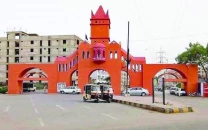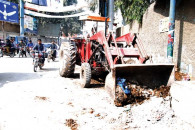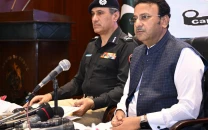Drawing parallels across party lines
Sindhi nationalist parties and the MQM don't see eye-to-eye on flood victim registration.

In fact, when the Pakhtun was forced to migrate from Dir and Swat due to the military operations in Khyber-Pakhtunkhwa, the MQM was not the only party to express strong reservations against their settlement in Sindh’s sprawling metropolis Karachi. Sindh’s nationalist parties also opposed a Pakhtun influx and staged protests. They argue that Sindh’s resources are already stretched to the limit and thus it can’t accommodate people from other ethnic backgrounds.
Now that a large number of Sindhis have started settling in relief camps in two traditional MQM strongholds — Karachi and Hyderabad — is the equation set to change?
For its part, the MQM maintains that it has no qualms about accommodating in Karachi flood survivors from interior Sindh. “Our only demand is that all of them should be registered first,” said MQM MNA Waseem Akhtar. This would help verify compensation claims. Registration would also keep a check on terrorists who might enter cities disguised as flood victims.
Akhtar agreed with the notion that the MQM and Sindh’s nationalist parties see eye to eye on the oppressive landlord system. “The Sindhi nationalist parties have been against the jageerdars from the start,” he acknowledged.
Akhtar explained that his party remains opposed to the influx of the Pakhtuns due to the military operations in Khyber-Pakhtunkhwa and the presence of Afghans in Karachi. “Even for the flood survivors, we say that whoever comes must be registered,” said Akhtar. “If anyone from KP tries to come [to Sindh], they should still first be accommodated in their own province. But if they come to Karachi, then they should be monitored strictly.”
Just as the MQM cites the threat of terrorism when there is talk of settling the Pakhtun in Sindh, Ayaz Latif Palijo of the Awami Tehrik draws on the Sindh-for-Sindhis card. “Pakistan was not founded to burden one province,” he said. “I believe people should be settled in their own province. As it is, there is a law and order situation in Karachi and an influx [of people] from some other province would only add fuel to the fire.”
There is, however, a measure of understanding that the people suffering from the floods would naturally make their way to the big cities of Hyderabad and Karachi. It was inevitable, argued Abrar Qazi, who split from the Awami Tehrik and formed his own group called the Awami Jamhoori Party. “Other cities don’t have the capacity to deal with such a huge influx of people,” he conceded, giving the example of Larkana that went under after just 100,000 people arrived there. “Around seven million people from Sindh alone have been affected.”
“Out of this total, around 1.7 million people belonged to the kachcha areas and they will surely return,” he claimed, adding that the government would have to take care of the rest of them by generating jobs and accommodation in the big cities. “After all, Karachi too is their city,” he said.
Jeay Sindh Qaumi Mahaz’s Bashir Qureshi argues that flood survivors should stay within the boundaries of their own province because, “it’s not like the entire province has been submerged. People from the Punjab especially and Khyber-Pakhtunkhwa should remain inside their provinces”.
Divergence
Even though the MQM’s Waseem Akhtar was happy to acknowledge that the party had an anti-jageerdar agenda in common with the nationalists, the nationalists weren’t as warm. Bashir Qureshi disagreed with the suggestion that nationalist parties seem to be converging on the agenda of the MQM. “Their slogans to wage a struggle against feudalism are hollow,” he argued, explaining that he believed that it was just the MQM’s way of “targeting Sindhi [voters]”.
“In Sindh, contrary to popular belief, there are not many jageerdaars. In fact they can be counted on one’s fingertips,” he claimed. The main threat is from corrupt army generals, most of whom, he alleged belonged to the Punjab. “Now why doesn’t the MQM talk about a struggle against these forces?” he asked, adding that the party instead chose to “invite” martial law to the country.
Qazi added that there was also one more crucial difference between the MQM and the nationalist parties. “We not only say that the people affected in K-P should not enter our province because our resources are limited. But we also say that other Urdu-speaking people from India and the Biharis of the subcontinent who the MQM wants to see settled in Karachi should not be allowed to come,” he said.
Nationalist parties and Hyderabad
Apart from mainstream political parties such as the Pakistan Peoples Party (PPP) and the MQM, nationalist parties too have a strong presence in Hyderabad.
The most prominent among them are GM Syed’s Jeay Sindh party and its many offshoots - Rasool Bakhsh Palijo’s Awami Tehrik (AT), Qadir Magsi’s Sindh Tarraqi Pasand Party (STPP) and Mumtaz Bhutto’s Sindh National Front. Others such as the Awami Jamhoori Party, Save Sindh Party, Sindh Awami Ittehad and Sindh Nationalist Progressive Alliance can at best be described as pressure groups and not political parties.
All the nationalist parties have a common agenda of waging a struggle against global imperial forces and feudalism. They are also united on Sindh’s water woes and demand complete provincial autonomy.
The first struggle of Sindhi nationalist forces has always been against influence of the Punjab over the province’s resources. They also consider the influence of Urdu- and Pashto-speaking peoples in Sindh as detrimental and at times equivalent to an “invasion” of the province by outside forces.
However, some of them do have Urdu-speaking people as members. “We don’t consider our Urdu-speaking friends outsiders - we think that they are in fact Sindhis,” Qureshi said, adding that his party was one of the first ones to include members from the Urdu-speaking community in interior Sindh.
Awami Tehrik’s Ayaz believes that his party would have to include Urdu-speaking members among its ranks. “Unless we get rid of polarisation in Sindh, we won’t be able to end the domination of the feudal class,” he said. The AT is now pushing the idea of including Urdu-speaking members in its ranks.
The Awami Tehrik, which was formed by Ayaz’s father Rasool Bakhsh Palijo in 1969, believes the solution to the country’s problems would come through socialism and democracy. “We don’t believe in revolution by the bullet, but only by the will of the people,” Ayaz said.
The AT is one of the largest organised parties dominant in lower Sindh and its leader Ayaz claims that it has more than 500,000 workers, including a large number of women supporters.
Also, some like the JS have a secessionist agenda and believe that a change can happen in the country only through a revolution, while others like the AT believe that a social democratic order is the way forward.
Educational institutions such as the University of Sindh in Jamshoro are a hub of activities for nationalist parties and most find their new recruits from here. It is here that middle class students from small towns and villages in interior Sindh come with ambitions to free their society from the clutches of poverty.
Despite GM Syed’s death, his theory for Sindh’s emancipation from the feudal class and alleged suppressive forces from Punjab remains to this day the leading guiding light for Sindh’s nationalist parties.
GM Syed had joined Jinnah’s Muslim League before Pakistan’s independence, but opted out of it once he felt that the new country would only amount to a change of masters from the white sahebs to the brown sahebs without any social reforms or protection for Sindh.
Future of nationalist parties
Qazi argued that although the nationalist parties are gaining ground, it would take years for them to become a dominant force. Despite the PPP-led government’s “complete failure” in taking care of its people, he said that if mid-term elections were to take place today and nationalist parties took part, no candidate would be able to win a seat.
However, a senior leader of the Sindh Tarraqi Pasand Party said his party was confident that it has gained a lot of support in the post-flood situation. “The PPP-led government has failed miserably on all fronts. The people of Sindh are frustrated with the efforts of the present government,” he said. This helps the nationalist parties who have been stressing from the start that parties such as the PPP and PML-N can never free them from the curse of poverty simply because they are part of the feudal class. “Nationalist parties provide the much-needed alternative to the people of Sindh.”
Published in The Express Tribune, September 28th, 2010.



















COMMENTS
Comments are moderated and generally will be posted if they are on-topic and not abusive.
For more information, please see our Comments FAQ